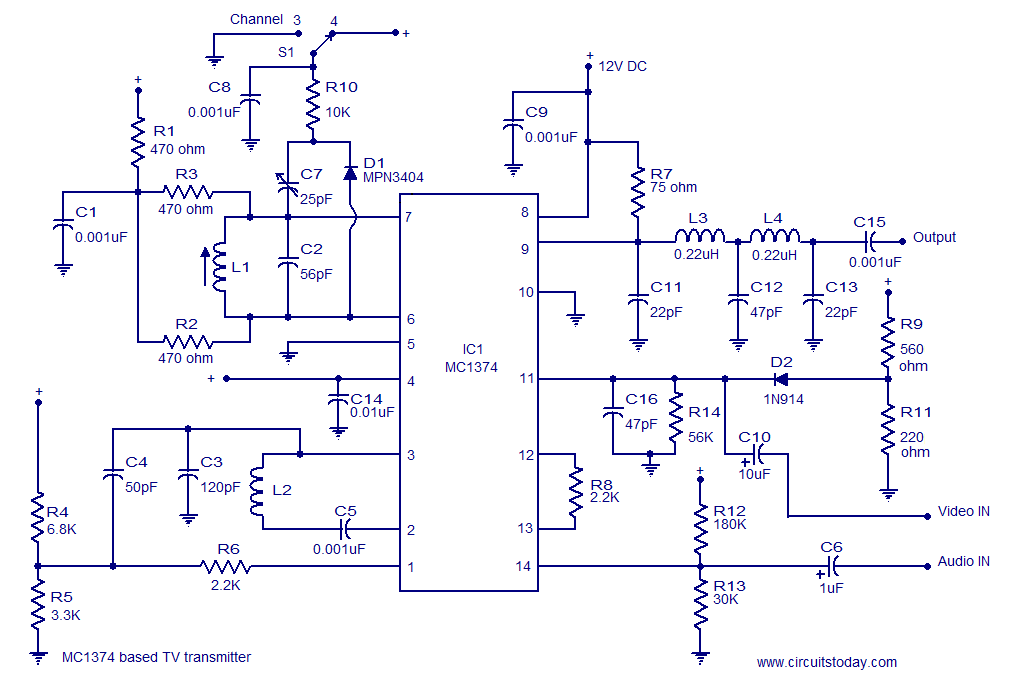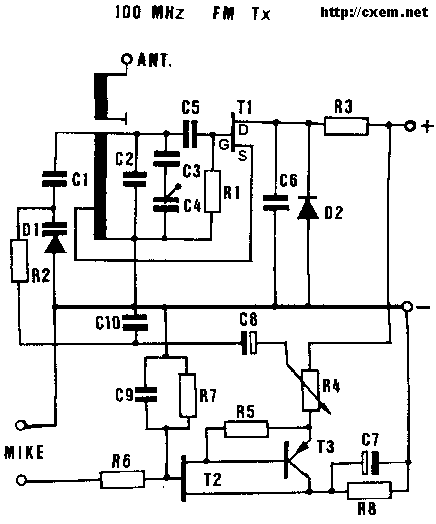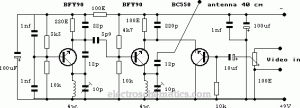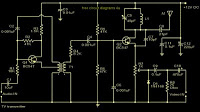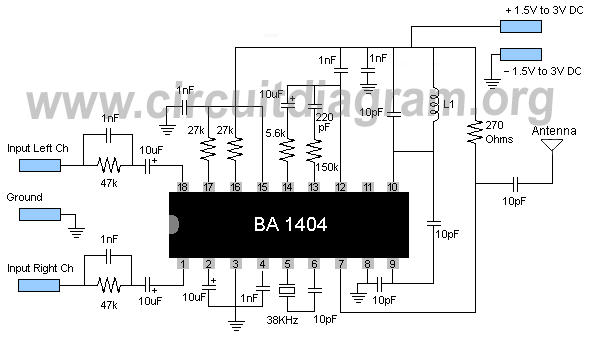
pippin qrp transmitter
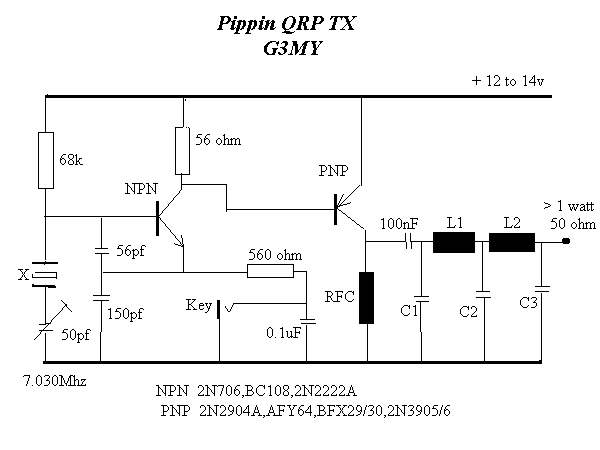
This circuit represents a conventional Colpitts type crystal oscillator, where the output is taken from a low-value collector load resistor. Direct coupling is implemented into the base of a PNP transistor used as an amplifier, resulting in a simplified circuit compared to the OXO design, while offering considerable advantages. The small amount of forward bias generated for the power amplifier (PA) stage facilitates easier driving, although it is insufficient to fully bias the stage "ON". Keying occurs in the emitter circuit of the oscillator stage; when the key is not engaged and no current is drawn, there is no forward bias applied to the PA stages. The isolation of the PA from the oscillator is achieved by deriving the drive from the low-value collector load of the oscillator, which effectively prevents any significant pulling of the oscillator even if the PA load is momentarily shorted to ground. The input to the PA stage operates at 120 to 150 mA at 12 to 14 volts, while the output at 7 MHz exceeds 1 watt when measured into a 50-ohm load. The PA transistor is equipped with a "Stove Pipe" heat sink and has been tested to run continuously for over one hour without any issues.
The circuit utilizes a Colpitts oscillator configuration, characterized by its use of a crystal for frequency stability. The oscillator consists of a tank circuit made from a combination of capacitors and an inductor, which helps define the oscillation frequency. The output is taken from the collector of the transistor, which is coupled to the base of the PNP transistor. This direct coupling allows for a straightforward design, minimizing component count and complexity.
In operation, the PA stage is designed to amplify the oscillator's output. The small forward bias generated by the oscillator ensures that the PA stage is in a ready state without drawing significant current when idle. This design choice enhances the overall efficiency of the circuit by reducing power consumption during non-active periods.
Keying the circuit is achieved through the emitter of the oscillator stage, providing a simple means to control the output signal. When the key is released, the lack of current flow ensures that the PA remains off, preventing unwanted power draw and heat generation. This feature is particularly beneficial in applications where power conservation is critical.
The design's isolation of the PA stage from the oscillator is a notable advantage, as it maintains the integrity of the oscillator's frequency. The low-value collector load resistor minimizes the interaction between the oscillator and the PA, allowing for stable operation even under varying load conditions. The circuit's resilience to load changes, such as a brief short to ground, demonstrates its robustness and reliability.
The PA stage's specifications indicate it operates efficiently at a current of 120 to 150 mA with a supply voltage between 12 and 14 volts. The output power of over 1 watt into a 50-ohm load at a frequency of 7 MHz suggests that the circuit is well-suited for applications requiring moderate power levels, such as in amateur radio or other RF transmission scenarios.
Thermal management is addressed through the implementation of a "Stove Pipe" heat sink on the PA transistor, which effectively dissipates heat generated during operation. The ability to run continuously for extended periods without overheating is a testament to the design's effectiveness and reliability in practical applications. Overall, this Colpitts oscillator and PA circuit combination presents a simplified yet highly functional solution for RF amplification needs.Basically, it is a conventional Colpitt type crystal oscillator but with the output taken from a low value collector load resistor and direct coupling is made into the base of the PNP device used as an amplifier. The result is a circuit even more simple than the OXO and with considerable advantages. The small amount of forward bias developed for t he PA stage makes it very much easier to drive but is less than the voltage required to actually bias the stage "ON". Keying is in the emitter circuit of the oscillator stage and when the key is up and no current is being drawn there is no forward bias at all on the PA stages.
The isolation of the PA from the oscillator by taking the drive from the low value oscillator collector load, is most impressive and there is virtually no pulling of the oscillator even if the PA load is briefly shorted to ground. Input to the PA stage runs at 120 to 150mA. at 12 to 14 volts and output on 7Mhz runs at better than 1 watt measured into a 50 ohm load. The PA transistor has a "Stove Pipe" heat sink attached and has been left running continously for more than 1 hour without any complaint from the PA stage.
🔗 External reference
The circuit utilizes a Colpitts oscillator configuration, characterized by its use of a crystal for frequency stability. The oscillator consists of a tank circuit made from a combination of capacitors and an inductor, which helps define the oscillation frequency. The output is taken from the collector of the transistor, which is coupled to the base of the PNP transistor. This direct coupling allows for a straightforward design, minimizing component count and complexity.
In operation, the PA stage is designed to amplify the oscillator's output. The small forward bias generated by the oscillator ensures that the PA stage is in a ready state without drawing significant current when idle. This design choice enhances the overall efficiency of the circuit by reducing power consumption during non-active periods.
Keying the circuit is achieved through the emitter of the oscillator stage, providing a simple means to control the output signal. When the key is released, the lack of current flow ensures that the PA remains off, preventing unwanted power draw and heat generation. This feature is particularly beneficial in applications where power conservation is critical.
The design's isolation of the PA stage from the oscillator is a notable advantage, as it maintains the integrity of the oscillator's frequency. The low-value collector load resistor minimizes the interaction between the oscillator and the PA, allowing for stable operation even under varying load conditions. The circuit's resilience to load changes, such as a brief short to ground, demonstrates its robustness and reliability.
The PA stage's specifications indicate it operates efficiently at a current of 120 to 150 mA with a supply voltage between 12 and 14 volts. The output power of over 1 watt into a 50-ohm load at a frequency of 7 MHz suggests that the circuit is well-suited for applications requiring moderate power levels, such as in amateur radio or other RF transmission scenarios.
Thermal management is addressed through the implementation of a "Stove Pipe" heat sink on the PA transistor, which effectively dissipates heat generated during operation. The ability to run continuously for extended periods without overheating is a testament to the design's effectiveness and reliability in practical applications. Overall, this Colpitts oscillator and PA circuit combination presents a simplified yet highly functional solution for RF amplification needs.Basically, it is a conventional Colpitt type crystal oscillator but with the output taken from a low value collector load resistor and direct coupling is made into the base of the PNP device used as an amplifier. The result is a circuit even more simple than the OXO and with considerable advantages. The small amount of forward bias developed for t he PA stage makes it very much easier to drive but is less than the voltage required to actually bias the stage "ON". Keying is in the emitter circuit of the oscillator stage and when the key is up and no current is being drawn there is no forward bias at all on the PA stages.
The isolation of the PA from the oscillator by taking the drive from the low value oscillator collector load, is most impressive and there is virtually no pulling of the oscillator even if the PA load is briefly shorted to ground. Input to the PA stage runs at 120 to 150mA. at 12 to 14 volts and output on 7Mhz runs at better than 1 watt measured into a 50 ohm load. The PA transistor has a "Stove Pipe" heat sink attached and has been left running continously for more than 1 hour without any complaint from the PA stage.
🔗 External reference

